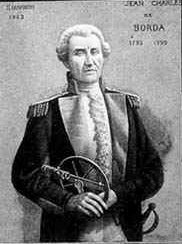- About MAA
- Membership
- MAA Publications
- Periodicals
- Blogs
- MAA Book Series
- MAA Press (an imprint of the AMS)
- MAA Notes
- MAA Reviews
- Mathematical Communication
- Information for Libraries
- Author Resources
- Advertise with MAA
- Meetings
- Competitions
- Programs
- Communities
- MAA Sections
- SIGMAA
- MAA Connect
- Students
- MAA Awards
- Awards Booklets
- Writing Awards
- Teaching Awards
- Service Awards
- Research Awards
- Lecture Awards
- Putnam Competition Individual and Team Winners
- D. E. Shaw Group AMC 8 Awards & Certificates
- Maryam Mirzakhani AMC 10 A Awards & Certificates
- Two Sigma AMC 10 B Awards & Certificates
- Jane Street AMC 12 A Awards & Certificates
- Akamai AMC 12 B Awards & Certificates
- High School Teachers
- News
You are here
The French Connection: Borda, Condorcet and the Mathematics of Voting Theory
Voting theory has become a standard topic in the undergraduate mathematics curriculum. Its connection to important issues within a democratic society and the accessibility of its methods make a unit on voting theory especially well-suited for students in liberal studies program, as well as for students at the high school level. The pièce de resistance of such a unit is a somewhat startling theorem due to economist and Nobel Prize laureate Kenneth Arrow (1921–2017): there is no fair voting system.
First formulated in Arrow’s doctoral dissertation (published as the monograph Social Choice and Individual Values [Arrow 1951], Arrow’s Impossibility Theory can be stated as follows:
When voters have three or more alternatives, there is no voting method that can convert the ranked preferences of individuals into a community-wide transitive ranking of those alternatives, while also meeting a pre-specified set of fairness conditions in every election.
In other words, no matter how we decide to combine the individual preferences of a group in order to select a single winner from a slate of three or more candidates, something will sometimes go wrong with the election results in a way that can be characterized as either “irrational” (due to the failure of transitivity) or “unfair”. Unpacking what this means by exploring the relationship between different methods for determining election results (called Methods of Voting) and different notions of fairness (called Fairness Criteria) is the primary objective of the standard undergraduate treatment of voting theory.
The study of specific voting methods and their drawbacks actually dates back well before Arrow’s twentieth-century work. Indeed, Iain McLean has remarked that “the theory of voting has in fact been discovered four times and lost three times” [McLean 1990, p. 99]. Arrow, of course, was responsible for the fourth discovery. McLean’s 1990 article examines the first discovery, made at the hands of two medieval thinkers, Ramon Lull (c. 1235–1315) and Nicolas of Cusa (1401–1464), within the context of ecclesiastical elections. More recently, McLean [2019] has written about the third discovery by Charles Dodgson (1832–1898), the British mathematician more widely known as Lewis Carroll, who was motivated to write on the topic as a result of certain election decisions made by the faculty at Christ Church, Oxford. Yet, as those familiar with today’s treatment of voting theory will know, none of the names of Lull, Cusa or Dodgson/Carroll are generally associated with the topic.
In contrast, the second time that this discovery was made involved two late eighteenth-century French mathematicians for whom certain key ideas of voting theory are now named: Jean Charles, Chevalier de Borda (1733–1799) and Marie-Jean-Antoine-Nicolas de Caritat, Marquis de Condorcet (1743–1794). In this article, we examine the temporarily “lost” texts that explain the attachment of their names to those ideas:
- Borda’s “Memoire sur les élections au scrutin” (“Memoir on elections by ballot”), published in 1784; and
- Condorcet’s Essai sur L’Application de L’Analyse a la Probabilité des Décisions Rendues à la Pluralité des Voix (Essay on the Application of the Analysis of Probabilities to Decisions Rendered by a Plurality of Votes), published in 1785.
|
|
|
We begin in the next section by considering the historical context in which these original works were written, together with biographical sketches of the professional lives of their authors in the period prior to the French Revolution, the start of which corresponds roughly to the publication dates of the two texts. We next provide an overview of the technical contents of the two texts as they pertain to the treatment of voting theory in today’s undergraduate curriculum. In the two penultimate sections of the article, we complete our biographical treatment of both men by sketching in a few details from their later lives, and also take a look at how their works were taken up (or not) by their contemporaries in France.
In closing, the final section of this article considers the role that Borda’s and Condorcet’s original texts and the related history could play within today’s classroom. For those interested in bringing their voices directly into the classroom conversation, we also offer a student project based on the original writings of Borda and Condorcet. That project, also entitled “The French Connection: Borda, Condorcet and the Mathematics of Voting Theory” (pdf), includes an appendix that further offers instructors the option of having students read more about the historical context in which Borda and Condorcet lived and worked, perhaps as part of an interdisciplinary unit with colleagues from history or the social sciences. For instructors who wish to dive even deeper into the project’s context or content during its classroom implementation, this article provides more detailed information, both historical and mathematical, than appears in either the project or its appendix. Let’s begin!
Janet Heine Barnett (Colorado State University – Pueblo), "The French Connection: Borda, Condorcet and the Mathematics of Voting Theory," Convergence (September 2020), DOI:10.4169/convergence20200922






